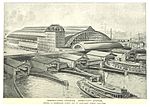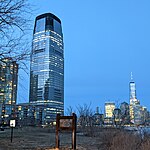Katyń Memorial (Jersey City)
The Katyń Memorial is a bronze statue created by Polish-American sculptor Andrzej Pitynski in dedication to the victims of the 1940 Katyn massacre, in which thousands of Polish Army officers and intellectual leaders who had been interned at Kozielsk or imprisoned at Ostashkov and Starobielsk had been killed by the occupying Soviet People's Commissariat for Internal Affairs, or NKVD. The memorial stands at Exchange Place in Jersey City, New Jersey, United States, near the mouth of the Hudson River. Unveiled in June 1991, the statue depicts a bound and gagged Polish soldier with a bayoneted rifle impaled through his back. The statue stands 34-foot-tall (10-meter) and is atop a granite base containing Katyn soil. Its base also depicts a Polish woman carrying her starving child in memorial to the Polish citizens deported to Siberia that began shortly before the massacre.
Excerpt from the Wikipedia article Katyń Memorial (Jersey City) (License: CC BY-SA 3.0, Authors).Katyń Memorial (Jersey City)
Exchange Place, Jersey City
Geographical coordinates (GPS) Address Nearby Places Show on map
Geographical coordinates (GPS)
| Latitude | Longitude |
|---|---|
| N 40.716111111111 ° | E -74.033055555556 ° |
Address
Starbucks
Exchange Place
07311 Jersey City
New Jersey, United States
Open on Google Maps











